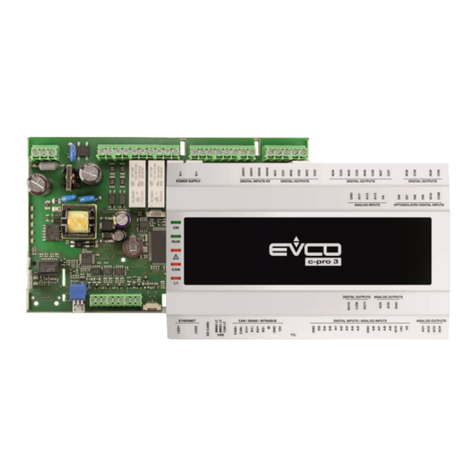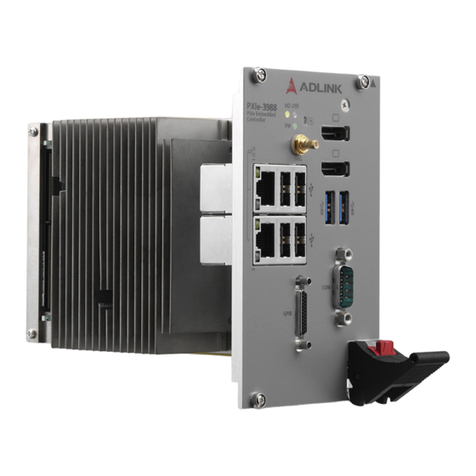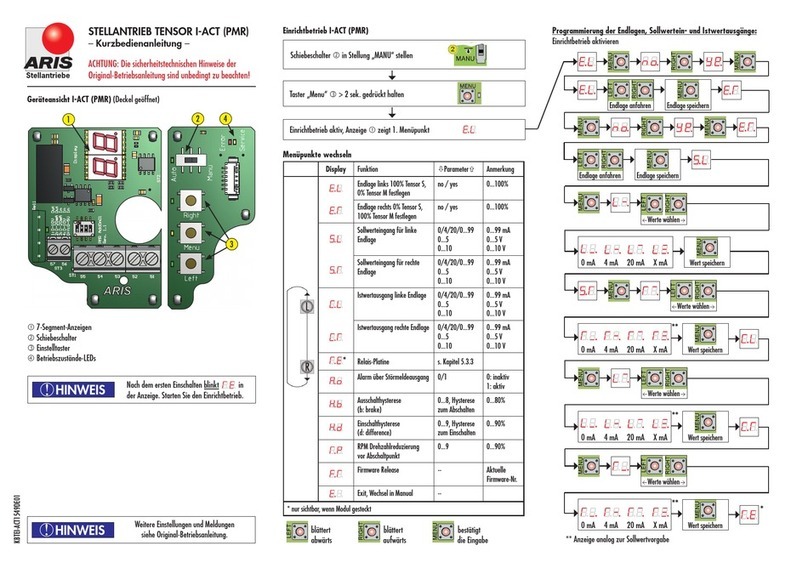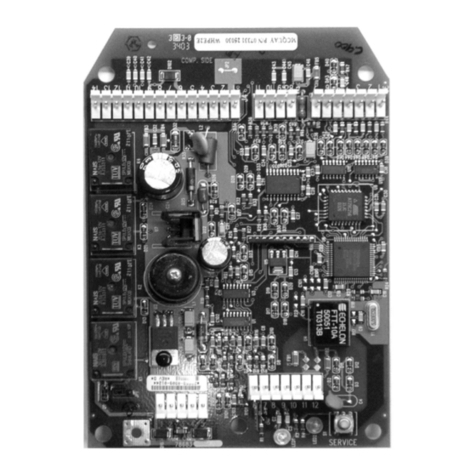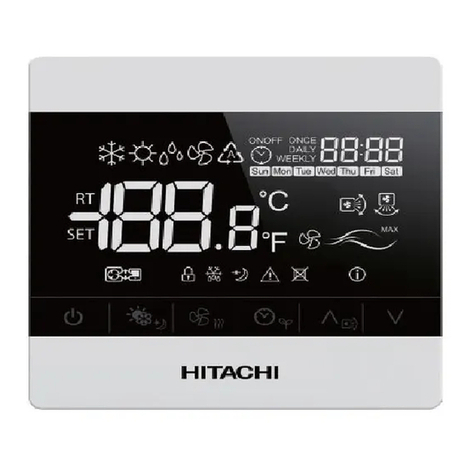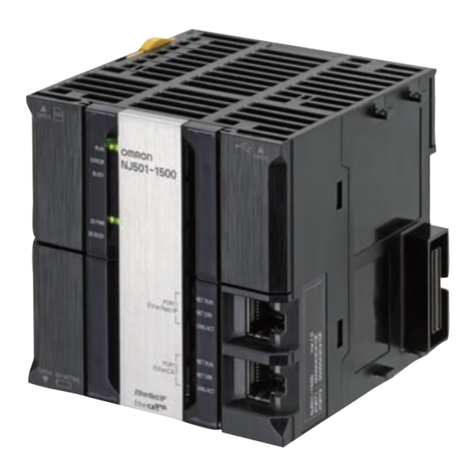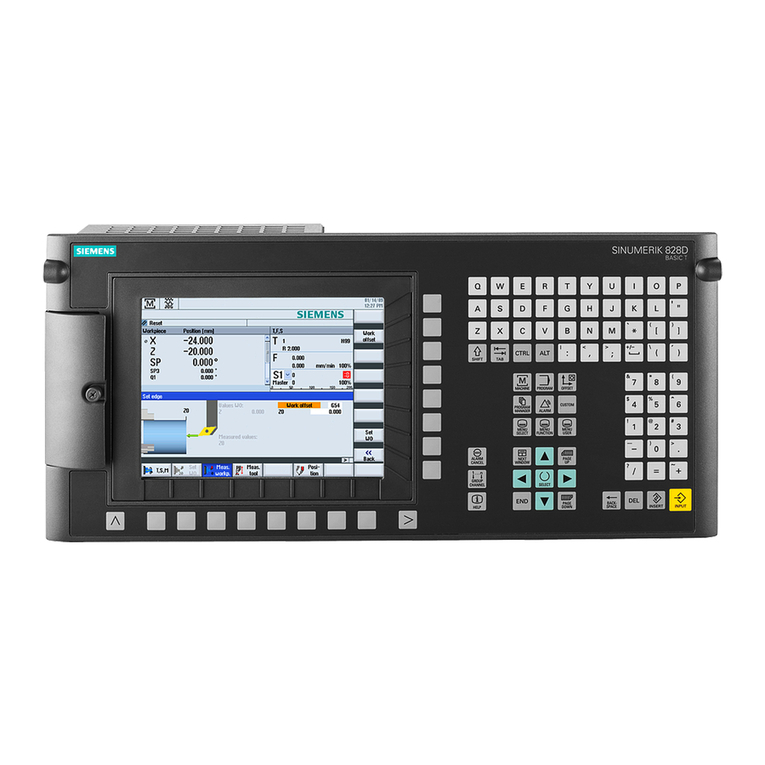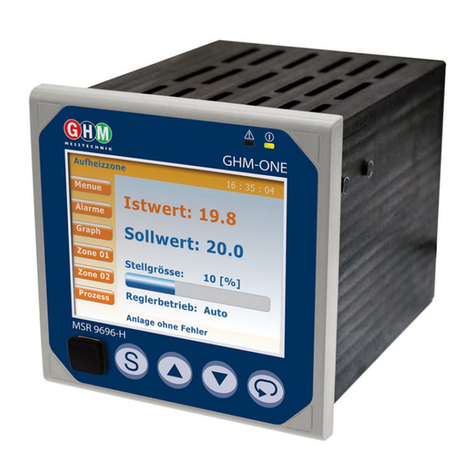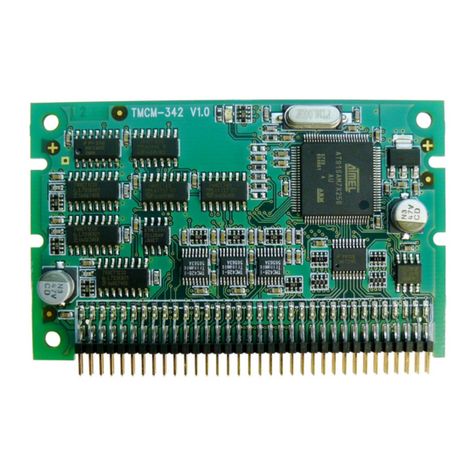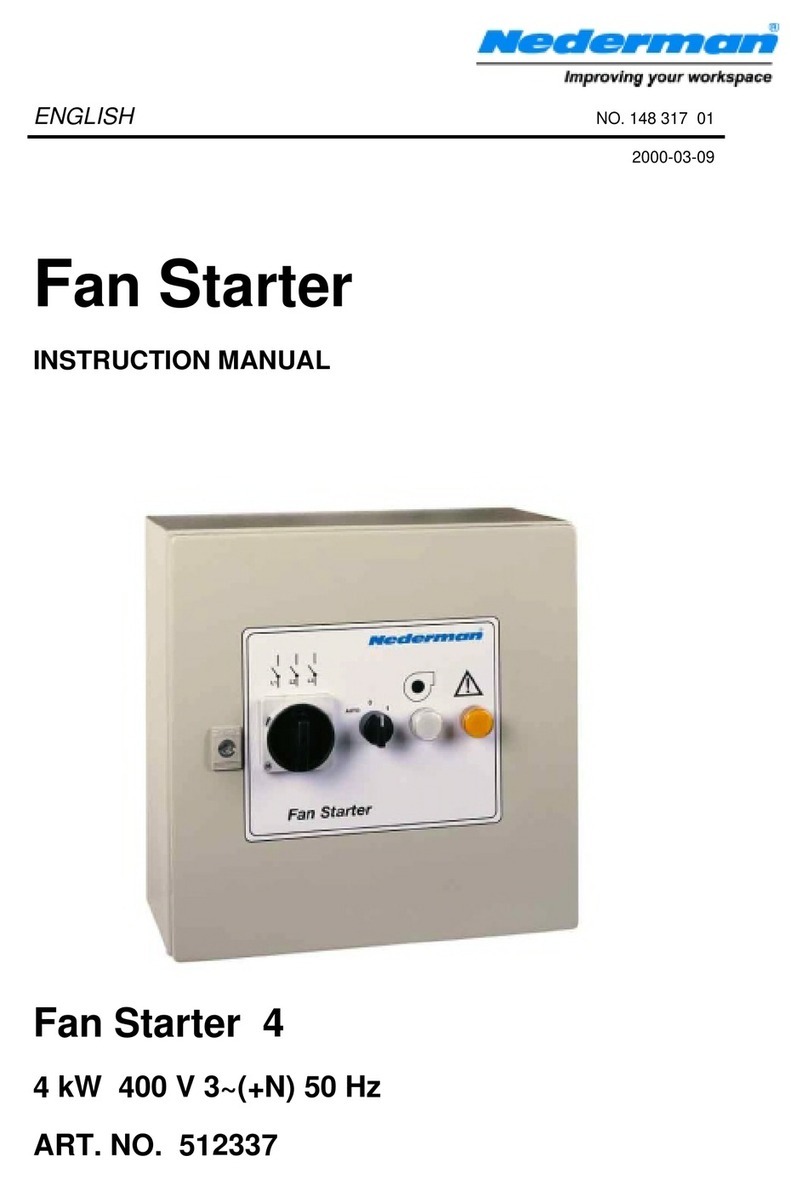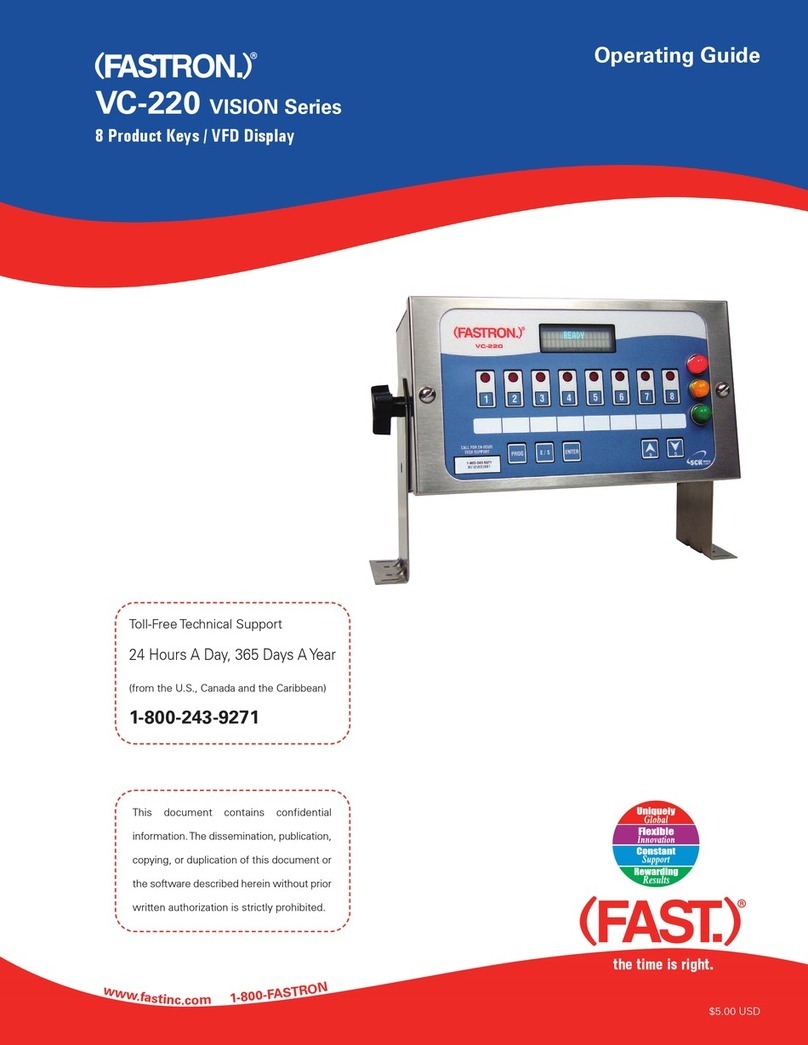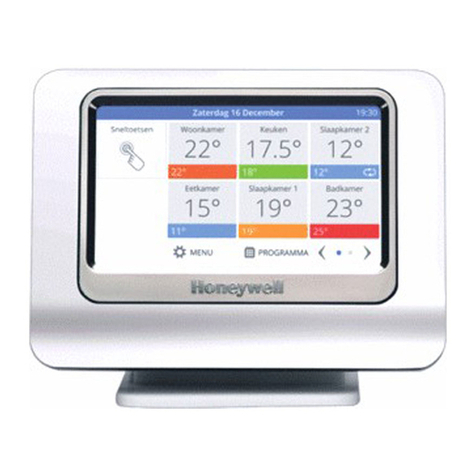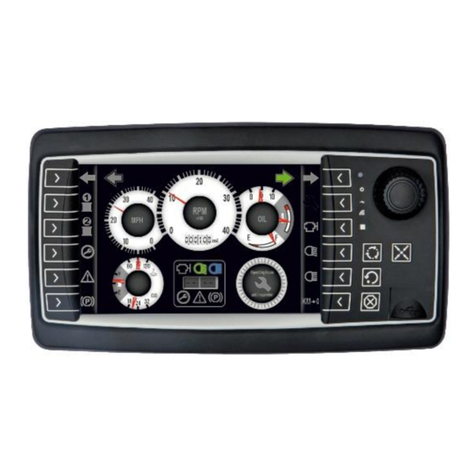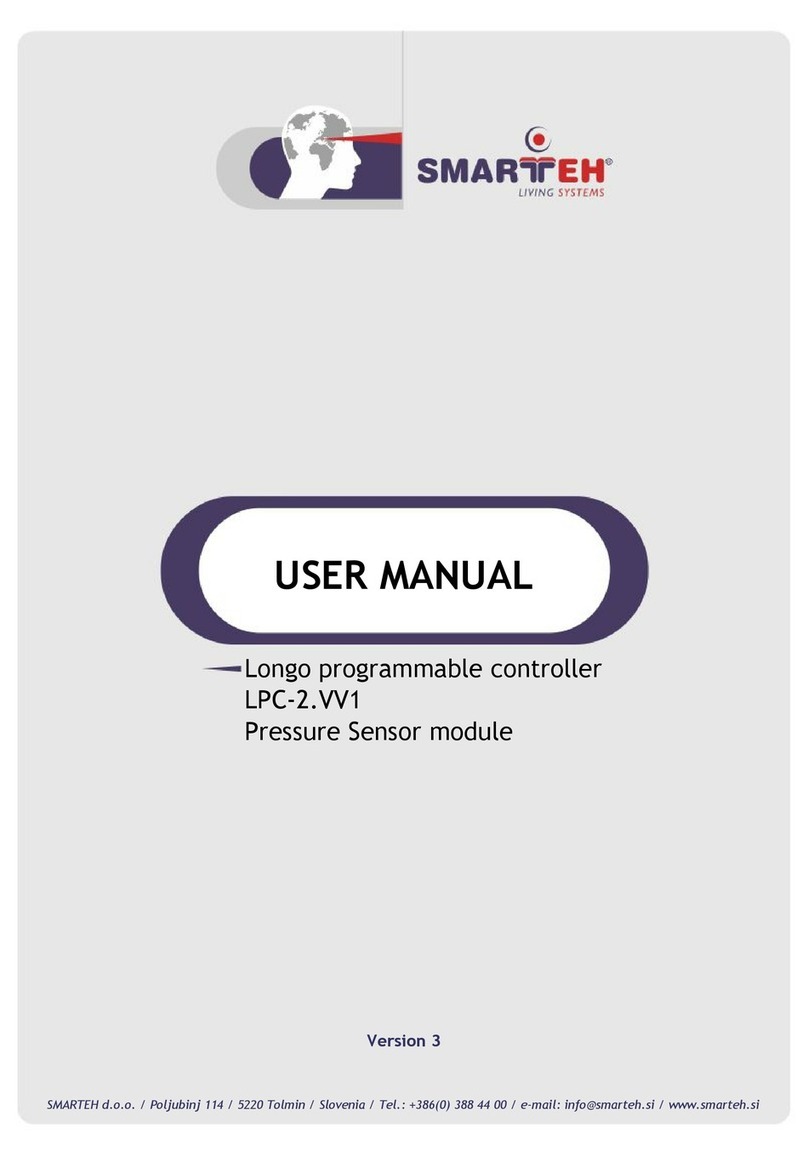ECKART SM4 User manual

C
HAN
C
E
N
f
ü
r n
eue
T
ec
hnik
e
n
.
Sch
w
enkmotor SM
4
U
ser
G
uid
e
Rotar
y
actuator SM
4

[ Vorwort ]
Genaue Kenntnisse über das Produkt
und eine gewissenhafte Befolgung der
Betriebsanleitung gewähren einen stö-
rungsfreien Dauerbetrieb. Inbetrieb-
nahme und Re araturen dürfen nur
durch fachkundiges und geschultes Per-
sonal durchgeführt werden.
Die Sicherheitsvorschriften der örtlichen
Institutionen sind zu beachten, z.B.
UVV, VDE, TÜV, etc.
Die mit einem Schwenkmotor betriebe-
nen Anlagen müssen so ausgelegt sein,
dass bei technischen oder menschlichen
Versagen keine Gefahr für Leib und
Leben besteht.
Die Betriebsanleitung ist vor dem Einbau
bzw. vor der Inbetriebnahme sorgfältig zu
lesen.
Sollten sich trotzdem einmal Schwierig-
keiten einstellen, so wenden Sie sich bitte
an unseren undendienst, der Ihnen gerne
behilflich sein wird.
Dieses Produkt ist nach dem heutigen
Stand der Technik gefertigt und zusam-
mengebaut worden und ist betriebssicher.
Die Einzelteile und das fertige Produkt
werden durch unsere Qualitätssicherung
(DIN EN ISO 9001) laufend überwacht.
Gegenüber Darstellungen und Angaben
dieser Betriebsanleitung sind technische
Änderungen, die zur Verbesserung dieses
Produktes notwendig werden, vorbehalten.
[ Preface ]
Possessing an exact knowledge of the
roduct and adhering conscientiously
to the User Guide will guarantee trouble-
free o eration. Start u and re airs
should only be erformed by ex erts
and trained staff.
Regional safety regulations should be
observed.
Maschinery driven by a rotary actuator
must be laid out in such a manner that
in case of technical or human failure
there is no danger of injury or fatal ac-
cident.
Please read the User Guide carefully be-
fore installation and start up.
Should you still encounter difficulties, con-
tact our customer service department, who
will be happy to help.
This product has been manufactured and
assembled in accordance with current
technical standards and is operationally
reliable. The individual parts and the end
product are checked continually by our
quality assurance department (DIN EN
ISO 9001).
We reserve the right to make technical al-
terations to the designs and specifications
of this User Guide, which are necessary to
improve this product.
S
chwenkmotor P
SM
Betriebsanleitung · User Guide
2

[ arranty ]
The information in this document can be
altered without prior notice.
Eckart GmbH issues no guarantee of any
kind with regard to this User Guide.
Eckart GmbH rejects the implied guaran-
tee of marketability and aptitude for a cer-
tain purpose.
Eckart GmbH is not liable for any direct,
indirect, collateral, consequential or other
damage in connection lines with the pro-
vision or use of this User Guide.
[ Explanation of symbols ]
They mean:
Warning, danger Information
S
chwenkmotor P
SM
Schwenkmotor SM4 · Rotary actuator SM4 3
[ Gewährleistung ]
Die in diesem Dokument enthaltenen Infor-
mationen können ohne vorherige Ankün-
digung geändert werden.
Eckart GmbH erteilt keine Gewährleistung
irgendwelcher Art hinsichtlich dieser Be-
triebsanleitung.
Eckart GmbH lehnt insbesondere die still-
schweigende Gewährleistung der Markt-
fähigkeit und Eignung für einen bestimmten
Zweck ab.
Eckart GmbH ist nicht für irgendwelche
direkten, indirekten, Neben-, Folge- oder
andere Schäden im Zusammenhang mit
der Bereitstellung oder Verwendung die-
ser Betriebsanleitung haftbar.
[ Symbolerklärung ]
Es bedeuten:
Warnung, Gefahr Hinweis

S
chwenkmotor P
SM
Betriebsanleitung · User Guide
4
Table of contents
1. Operation 6
2. Information 6 - 7
3. Before installation 7 - 8
4. Installation 8 - 9
5. Start up 9 - 11
6. Drive s aft datum 11
7. Adjusting
t e drive s aft datum 12 - 15
8. Direction of rotation 15
9. Operating pressure 15
10. Backlas 16
11.
Angle of rotation setting
16 - 17
12. Hydraulic fluid 18
13. C anging ydraulic fluids 18
14. Operating temperature 18
15. Filtration 19
16. Leakage 19
17. End position 19 - 20
18. Torque output 20
19. Resetting forces 20
20. Pressure supply lines 21
21. Load valves 21
22. Maintenance 21
23. End cus ioning 22 - 25
24. Positioning 25
25. Storage 26
26. Weig t 26
27. Replacement parts,
list of replacement parts 26
Inhalt
1. Funktionsbesc reibung 6
2. Hinweise 6 - 7
3. Vor dem Einbau 7 - 8
4. Einbau 8 - 9
5. Inbetriebna me 9 - 11
6. Nullstellung der Abtriebswelle
11
7. Veränderung
der Nullstellung 12 - 15
8. Dre ric tung 15
9. Betriebsdruck 15
10. Dre winkelspiel 16
11. Dre winkeleinstellung 16 - 17
12. Druckflüssigkeit 18
13. Druckflüssigkeitswec sel 18
14. Betriebstemperatur 18
15. Filterung 19
16. Leckage 19
17. Endlage 19 - 20
18. Dre moment 20
19. Rückstellkräfte 20
20. Ansc lussleitungen 21
21. Sperrventile 21
22. Wartung 21
23. Endlagendämpfung 22 - 25
24. Positionieren 25
25. Lagerung 26
26. Gewic t 26
27. Ersatzteile,
Ersatzteilliste 26

[ Schnittbild ](Bild-1)
•A - Drehrichtung Gegen-Uhrzeigersinn
(bei Druckeintritt in Anschluss A)
•B - Drehrichtung Uhrzeigersinn
(bei Druckeintritt in Anschluss B)
•F - Blickrichtung
•GW- Gewindebohrung Abtriebswelle
•A1 - Anschluss A1
•B1 - Anschluss B1
•G1 -
Gewindepaarung Welle– olben
•G2 -
Gewindepaarung Zahnring– olben
•E1 - Endanschlag Flansch
•E2 - Endanschlag Boden
•S1 - Entlüftung Flansch
•S2 - Entlüftung Boden
• - olben
•W - Abtriebswelle
•RE - Reguliereinsatz
• M - ontermutter
•Y -
Zylinderkopfschraube Reguliereinsatz
•Z -
Zylinderkopfschraube Nullstellung
[ Sectional drawing ](figure-1)
•A - Shaft rotation anti-clockwise
(by admittance of pressure in port A)
•B - Shaft rotation clockwise
(by admittance of pressure in port B)
•F - Direction of view
•GW- Threaded bore drive shaft datum
•A1 - Port A1
•B1 - Port B1
•G1 - Helical gear shaft
•G2 - Helical gear ring
•E1 - End stop flange
•E2 - End stop base
•S1 - Bleed port Flange
•S2 - Bleed port bottom
• - Piston
•W - Drive-shaft
•RE - Adjustable stop on buttom
• M - Locking nut
•Y - Cylinder head control insert
•Z - Cylinder head datum
S
chwenkmotor P
SM
Schwenkmotor SM4 · Rotary actuator SM4 5
WGW
F
Z
S2
KM
K
E1 E2
G1
B1 G2
Y
A
S1
B
A1
RE
Bild-1 / figure-1

S
chwenkmotor P
SM
Betriebsanleitung · User Guide
6
[ 1. Funktionsbeschreibung ]
Der Schwenkmotor SM4 wird zum
Schwenken oder Drehen von Nutzlasten
mit begrenztem Drehwinkel eingesetzt.
Der olben (siehe Bild 1 auf Seite 5)
wird, wie in einem Hydraulikzylinder,
durch hydraulische raft zwischen den
zwei mechanischen Endlagen E1 und E2
linear bewegt.
Die Linearbewegung wird mechanisch,
durch die mehrgängigen Steilgewinde
G1 und G2 in eine Drehbewegung um-
gewandelt und auf die Abtriebswelle W
übertragen.
Die Steilgewindepaarungen sind nicht
selbsthemmend. Durch Zwangsschmie-
rung und nitrierte Oberflächen der Steil-
gewinde ist eine hohe Lebensdauer des
Schwenkmotors gewährleistet.
[ 2. Hinweise ]
●Stellen Sie sicher, dass niemand
in den Schwenkbereich der be-
weglichen Masse greifen kann,
und keine Fremdgegenstände
dorthin gelangen (z.B. mit selbst-
gefertigtem Schutzgitter).
●Verwenden Sie bei Zubehör nur
zugelassene Bauteile. Beachten
Sie die Vorschriften der Her-
steller für z.B. Verschraubungen,
Rohre, Schlauchleitungen, Venti-
le, etc.
●Sichern Sie den Schwenkmotor
gegen hydraulische und mecha-
nische Überlastung, z.B. durch
Sicherheitsventile, ext. Anschlä-
ge, etc..
●Vorsicht bei Betrieb mit Speicher-
anlagen! Speicheranlagen kön-
nen auch bei abgeschalteter
Pumpe noch unter Druck stehen.
[ 1. Operation ]
The rotary actuator SM4 is used for rota-
ting or turning useful loads with limited ro-
tation angle.
As in a hydraulic cylinder the piston (see
figure-1 on page 5) is moved in a linear
motion between the two mechanical end
positions E1 and E2 by means of
hydraulic power.
Through the multiple helical gears the
linear motion is mechanically transformed
into a turning motion and transferred to the
drive shaft W.
The pairs of helical gears are notself-
inhibiting. Positive lubrication and nitriding
of the surfaces of the helical gears ensures
a long service life of the rotary actuator.
[ 2. Information ]
●Make sure that nobody can
place the hand in the swivel
range of the moveable mass,
and that no objects lie in the path
of the moveable mass (e.g. with
shopmade protective grill).
●Only use permitted parts when
adding fittings. Observe the
manufacture’s guidelines for
example for threaded joints,
tubing, flexible sheathed cables
and valves, etc.
●Protect the rotary actuator
against hydraulic and mecha-
nical overloading, by using for
example safety valves, ext. end
stops etc.
●Caution during operation with
accumulators. Accumulators can
still be under pressure even when
pumps are turned off.

[ 2. Hinweise ]
●Bei Verwendung von Sperr-
ventilen kann auch nach druck-
losgeschalteter Versorgungsan-
lage der Schwenkmotor noch
unter Druck stehen.
●Es ist empfehlenswert an Stelle
der Entlüftungsschrauben S1–S2
G1/8“ Entlüftungsventile oder
Messanschlüsse einzusetzen,
womit immer eine problemlose
Entlüftung und hydraulischer Ent-
spannung vorgenommen wer-
den kann.
[ 3. Vor dem Einbau ]
●Untersuchen Sie den Schwenk-
motor vor dem Einbau auf evtl.
Transportschäden oder sonstige
Beschädigungen. Garantiefor-
derungen durch Beschädigun-
gen können nach Einbau oder
Inbetriebnahme nicht akzeptiert
werden.
●Überprüfen Sie ob die Techni-
schen Daten des Schwenk-
motors mit den Anforderungen
übereinstimmen.
●Überprüfen Sie vor dem Einbau
die Nullstellung der Abtriebs-
welle (siehe apitel 6/7). Diese
kann in beliebiger Position stehen.
●Bringen Sie die Nullstellung der
Abtriebswelle in die für den
Einbau notwendige Position.
Dies geschieht entweder durch
mechanisches Drehen der Ab-
triebswelle W oder durch eine
hydraulische Betätigung des
Schwenkmotors.
[ 2. Information ]
●When using load valves even
after the supply system pressure
has been switched off the rotary
actuator may still be under pres-
sure.
●We recommend replacing the
bleed screws S1 – S2 G1/8“
with bleed valves or measuring
connectors, whereby a trouble-
free bleeding and hydraulic
release can be undertaken.
[ 3. Before installation ]
●Examine the rotary actuator be-
fore installation for possible
damage during transportation or
other damage. Claims for dama-
ges under the guarantee cannot
be accepted after installation or
start up.
●Check that the technical data for
the rotary actuator complies with
requirements.
●Check the datum of the drive
shaft (see section 6/7). It can be
in any position.
●Move the drive shaft into the
position required for installation.
This happens either by turning
the drive shaft mechanically or
through hydraulic operation of
the rotary actuator.
S
chwenkmotor P
SM
Schwenkmotor SM4 · Rotary actuator SM4 7

S
chwenkmotor P
SM
Betriebsanleitung · User Guide
8
[ 3. Vor dem Einbau ]
●Bei Druckbeaufschlagung in
Anschluss B1 dreht sich die
Abtriebswelle in Richtung B
(Uhrzeigersinn) und der olben
bewegt sich in Richtung E1 bis
zur internen mechanischen End-
lage. Diese Endlage ist die
Grundstellung und nicht verstell-
bar.
●Bei Druckbeaufschlagung in
Anschluss A1 dreht sich die
Abtriebswelle in Richtung A
(gegen Uhrzeigersinn) und der
olben bewegt sich in
Richtung E2 bis zur internen
mechanischen Endlage. Diese
Endlage ist verstellbar (siehe
apitel 11).
[ 4. Einbau ]
●Farbe oder sonstige anhaften-
den Fremdteile müssen von der
Flanschauflage entfernt werden.
●Es ist darauf zu achten, dass die
Abtriebswelle W mit der Nabe,
sowie die Flanschflächen genau
fluchten, da sonst die maximal
zulässigen Radial- und Axialkräf-
te überschritten werden können.
●Zur Montage der Abtriebswelle
W mit der Nabe ist die erfor-
derliche Axialkraft durch Schub
über das Wellenende der
durchgehenden Abtriebswelle
W oder durch Zug mittels Ge-
windestange am Gewinde GW
vorzunehmen. Eine andere Mon-
tageweise kann bei Schwer-
gängigkeit zur Überschreitung
der Axialkraft und damit zum
Lagerschaden führen.
[ 3. Before installation ]
●When pressure is applied in port
B1 the drive shaft turns in direc-
tion B (clockwise) and the piston
moves in direction E1 up to the
internal mechanical end position.
This end position is the positve
stop and is not adjustable.
●When pressure is applied in port
A1 the drive shaft turns in direc-
tion A (anti-clockwise) and the
piston turns in the direction E2
to the internal mechanical end
position. This end position is
adjustable (see section 11).
[ 4. Installation ]
●Paint or other parts stuck to the
flange must be removed.
●Care should be taken to align
the drive shaft W perfectly with
the hub and the flange surfaces,
to avoid exceeding the maxi-
mum permitted radial and axial
forces.
●The required axial force for mo-
unting the drive shaft on the hub
can be generated by pushing on
the end of the continuous drive
shaft W or by pulling using the
threaded rod on the thread GW.
Mounting using a different me-
thod can mean exceeding the
axial force if there is tightness
and this can lead to bearing da-
mage.
B1
A1
B
A

[ 4. Einbau ]
●Bei der Zusatzeinrichtung End-
lagendämpfung Z1 muss bei
einigen Baugrößen vor Befes-
tigung des Schwenkmotors die
Drosselschraube DS mit der
Dichtmutter DM an der Flansch-
seite entfernt werden (siehe
Seite 22). Nach der Befestigung
des Schwenkmotors sind diese
wieder einzusetzen (siehe a-
pitel 24).
●Weiterhin ist darauf zu achten,
dass die Anschlussleitungen bis
zum Wegeventil so kurz wie
möglich gehalten werden, um
einen Druckflüssigkeitsaustausch
zu garantieren.
●Vor Anschluss der Rohrleitungen
ist das Rohrsystem gründlich zu
reinigen. Warm behandelte
Rohre sind evtl. zu beizen.
●Bei eventuellem Ersatzteilwech-
sel ist in jeden Fall der Schwenk-
motor auszubauen. Hierzu ist
der erforderlichen Freiraum zu
berücksichtigen, um einen Ersatz-
teilwechsel problemlos durch-
führen zu können.
[ 5. Inbetriebnahme ]
●Bei der Inbetriebnahme muss
sehr sorgfältig vorgegangen
werden. Bei unsachgemäßer
Handhabung kann der Schwenk-
motor beschädigt oder zerstört
werden.
●Vor der ersten Bewegung sind
beide Druckkammern des
Schwenkmotors mit der Druck-
flüssigkeit zu füllen! Das Befüllen,
sowie die ersten Bewegungen
sollten, wenn möglich, ohne Last
geschehen.
[ 4. Installation ]
●When the end cushioning option
Z1 is used and before the in-
stallation of the rotary actuator,
remove the flow control screw
DS and seal lucking nut DM (see
page 22). You will now have
access to the front mounting
bold. After the rotary actuator
has been mounted the cushion
assembly put back in place (see
section 24).
●Additional care should be taken
that the supply lines to the direc-
tional valve are kept as short as
possible to guarantee an ex-
change of hydraulic fluid.
●Before connecting the piping the
pipe system should be cleaned
thoroughly. Heat-treated pipes
should be scoured.
●When changing the replace-
ment parts the rotary actuator
needs to be dismantled. It is
therefore necessary to allow
enough clearance for this to be
carried out without any problem.
[ 5. Start up ]
●Care must be taken during the
start up. If handled improperly
the rotary actuator could be
damaged or ruined.
●Before the first movement, the ro-
tary actuato‘s pressure cham-
bers must be filled with hydraulic
fluid. Filling of the chambers and
the first movement should ideally
take place without a load.
S
chwenkmotor P
SM
Schwenkmotor SM4 · Rotary actuator SM4 9

S
chwenkmotor P
SM
Betriebsanleitung · User Guide
10
[ 5. Inbetriebnahme ]
Ist dies aus technischen Gründen
nicht möglich, muss bei der Befül-
lung und der Erstbetätigung, be-
sonders sorgfältig vorgegangen
werden.
●Betriebsdruck und Flussmenge
müssen auf ein Minimum redu-
ziert werden.
●Bei Vorhandensein von einstell-
baren Drosselventilen sind diese
zu schließen und nach und nach
bei wechselseitiger Druckbeauf-
schlagung langsam zu öffnen.
Parallel dazu sollten beide
Druckkammern durch wechsel-
seitiges Öffnen der Entlüftungs-
schrauben S1– S2 entlüftet wer-
den.
●Um einen bequemen und saube-
ren Entlüftungsvorgang durch-
führen zu können, sind an Stelle
der Entlüftungsschrauben S1 –
S2 G1/8“ Entlüftungsventile
oder Messverschraubungen zu
empfehlen.
●Ein nicht mit Druckflüssigkeit be-
füllter Schwenkmotor kann bei
Erstbetätigung, je nach Einsatz-
fall, bereits beschädigt oder zer-
stört werden.
●Nachdem sichergestellt ist,
dass beide Druckkammern des
Schwenkmotors gefüllt und ent-
lüftet sind, kann vorsichtig mit
dem Betrieb begonnen werden.
Nach einigen Bewegungen des
Schwenkmotors kann mit max.
Betriebsdruck und Ölmenge ge-
arbeitet werden.
[ 5. Start up ]
If this is not be possible for tech-
nical reasons, extra special care
must be taken when filling the
chambers and during the first
operation.
●The operating pressure and
flows should be reduced to a
minimum if possible.
●When the cushion option ist used
the flow control screw should be
closed and opened slowly allo-
wing pressure in both directions.
At the same time, bleed the
actuator by opening the bleed
screws S1 then S2.
●To ensure that bleeding is easy
and clean it is recommended
that bleed valves or test fittings
are used instead of bleed screws
S1 and S2.
●A rotary actuator not filled with
hydraulic fluid can be damaged
or destroyed during its first ope-
ration depending on the indivi-
dual case.
●Once it has been determined
that both pressure chambers
have been filled and bled, the
operation can be started with
caution. After a few movements
of the rotary actuator it can be
operated with maximum pressure
and maximum amount of oil.

[ 5. Inbetriebnahme ]
●Sollten die zuvor beschriebenen
Vorgehensweisen aus techni-
schen Gründen nicht möglich
sein, muss der Schwenkmotor
mittels Handpumpe oder lein-
aggregat über die Gewinde-
bohrungen der Belüftungs-
schrauben S1 – S2 G1/8“
befüllt werden.
●Bei Schwenkmotoren mit Endla-
gendämpfung Z1 ist vor dem
Betrieb mit max. Leistung die
Endlagendämpfung entspre-
chend abzustimmen (siehe a-
pitel 24).
[ 6. Nullstellung der Abtriebswelle ]
Die Nullstellung der Abtriebswelle
erfolgt werksseitig wie im Bild-2
dargestellt, bei olben in Endlage
E1.
[ 5. Start up ]
●Should the procedures described
above not be possible for technical
reasons, the rotary actuator must
be filled using a hand pump or
small unit via the threaded bores
of the bleed screws S1 – S2
G1/8”.
●In the case of rotary actuators
with end cushioning Z1, the end
cushioning should be adjusted
before operation for maximum
power (see section 24).
[ 6. Drive Shaft Datum ]
The drive shaft datum is adjusted at
the factory as shown in figure-2,
with the piston resting against the
end stop E1.
S
chwenkmotor P
SM
Schwenkmotor SM4 · Rotary actuator SM4 11
Bild-2 / figure-2
W
FA
A1
S1 S2 Z
E1 E2
KB1
B
=
=
90° + 1°
Werkseinstellung
adjusted by manufactor

S
chwenkmotor P
SM
Betriebsanleitung · User Guide
12
[ 7. Veränderung der Nullstellung ]
●Die Nullstellung der Abtriebs-
welle kann individuell verstellt
werden. Die Einstellung sollte
möglichst vor der Montage der
Last vorgenommen werden.
●Der olben wird durch Druck-
beaufschlagung an B1 oder
durch Drehen der Abtriebswelle
W in Drehrichtung B (Uhrzeiger-
sinn) in die Endlage E1 ge-
bracht.
●Bei Schwenkmotoren mit der Zu-
satzeinrichtung Endlagendäm-
pfung Z1 (ohne Abbildung) ist
zu empfehlen durch Linksdrehen
der Drosselschraube DS die
Dämpfungswirkung zu neutrali-
sieren, da sonst der olben
durch die Dämpfungswirkung
aus der Endlage E1 verschoben
werden kann (siehe Bild-2).
Durch Öffnen der Entlüftungs-
schrauben S1 und S2 kann die
Dämpfungswirkung ebenfalls
neutralisiert werden.
●Nun müssen beide ammern
des Schwenkmotors drucklos
gemacht werden. Hierzu ist es
empfehlenswert anstelle der
Entlüftungsschrauben S1 – S2
Entlüftungsventile oder Mess-
verschraubungen zu verwenden.
●ACHTUNG: Es darf keine Last
von außen auf die Abtriebswelle
W einwirken, da die Last nach
dem Lösen der Zylinderkopf-
schrauben Z in eine unkontrollier-
te und gefährliche Bewegung
geraten kann.
[ 7. Adjusting the drive shaft datum ]
●Adjustment of the drive shaft da-
tum can be carried out individu-
ally. If possible setting should be
carried out before the load is
placed.
●The piston is brought in the end
position E1 through oil pressure
at B1or through turning the drive
shaft W in direction B (clock-
wise).
●In the case of rotary actuators
with the attachment end cushio-
ning Z1 (not illustrated) the back-
pressure action should be neu-
tralised by turning the flow
control screw DS to the left,
otherwise the piston can be pus-
hed out of the stroke stop flange
by the backpressure action (see
figure-2). The backpressure ac-
tion can also be neutralised by
opening the bleed screws S1
and S2.
●Both chambers of the rotary
actuator must now be depres-
surised. It is recommended that
bleed valves or test fittings be
used instead of bleed screws S1
and S2.
●CAUTION: There must be no
external load on the drive shaft
W as once the cylinder cap
screws Z have been loosened
the load could move about in an
uncontrolled and dangerous
way.
B1
B

[ 7. Veränderung der Nullstellung ]
●Zur Veränderung der Nullstel-
lung werden die Zylinderkopf-
schrauben Z nur soweit gelöst,
dass keine Berührung der
Schraubenkopfflächen mit den
Anschraubflächen mehr besteht.
●Bevor die Zylinderkopfschrau-
ben Z gelöst werden und der
Schwenkmotor drucklos ge-
macht wird, ist es empfehlens-
wert die Drehwinkelposition mit
einem geeigneten Messmittel
(z.B. ein Hebel am Wellenende
und Messuhr) zu überwachen
um etwaige Drehwinkelverände-
rungen beim Lösen der Schrau-
ben zu erkennen und mit dem
Verstellvorgang kompensieren
zu können.
●Durch Drehen der Abtriebswelle
W in Drehrichtung B (Uhrzeiger-
sinn) wird die gewünschte Pass-
federstellung erreicht.
●Beim Überschreiten der ge-
wünschten Nullstellung sollte die
Abtriebswelle W nicht in Dreh-
richtung A (gegen Uhrzeiger-
sinn) zurückgedreht werden,
sondern um 360weiter in
Drehrichtung B bis zum erneuten
Erreichen der gewünschten
Passfederstellung gedreht wer-
den. Eine orrektur durch ent-
gegengesetztes Verdrehen der
Abtriebswelle W in Drehrichtung
A ist nicht empfehlenswert.
●Sollte eine Verstellung der Pass-
federlage durch Drehen der
Abtriebswelle W in Richtung A
nötig sein, bitten wir um Rück-
s rache im Werk.
[ 7. Adjusting the drive shaft datum ]
●To adjust the drive shaft, loosen
the cylinder cap screws Z to
where the bolt head is no longer
in contact between the bottom
flange and the haeds of the cy-
linder cap screws.
●Before the cylinder cap screws Z
are loosened and the rotary
actuator is depressurised, we re-
commend monitoring the angle
of rotation with a suitable mea-
suring device (e.g. a lever at the
shaft pivot and a dial gauge) to
detect any possible changes in
the angle of rotation and to com-
pensate by making the appro-
priate adjustment.
●By turning the drive shaft W in di-
rection B (clockwise) the desired
key setting can be made.
●Should the desired position be
passed, the drive shaft W should
not be turned back in direction A
(anti-clockwise), but should be
turned 360forwards in direc-
tion B until the desired key setting
is reached again. Correction by
turning the drive shaft W in di-
rection A is not recommended.
●If adjusting the keys by turning
the drive shaft W in direction A is
only o tion, lease contact the
manufactory.
S
chwenkmotor P
SM
Schwenkmotor SM4 · Rotary actuator SM4 13
B
A

S
chwenkmotor P
SM
Betriebsanleitung · User Guide
14
[ 7. Veränderung der Nullstellung ]
●ACHTUNG: Bei Schwenkmo-
toren mit der Zusatzeinrichtung
Endlagendämpfung Z1 ist zu
berücksichtigen, dass beim
Verstellen der Nullstellung die
Schlitze und Fixierbohrungen
der Dämpfungsringe DR in den
Bereich der Dämpfungsboh-
rungen D gelangen können, wo-
durch die Endlagendämpfung
wirkungslos wird (siehe apitel
24).
Sollte bei Schwenkmotoren mit
Endlagendämpfung Z1 eine
Verstellung von mehr als 10not-
wendig werden ist eine Rück-
sprache mit dem Werk empfeh-
lenswert.
●Ist die vorgenommene Ver-
stellung der Nullstellung in
Ordnung sind die Zylinderkopf-
schrauben Z über reuz mit
einem Voranziehmoment MV
und einem Endanziehmoment
MEanzuziehen. Die Anzugsmo-
mente entnehmen Sie der Tabelle
Seite 15.
●ACHTUNG: Die vorgegebenen
Anziehmomente MV und ME
sind unbedingt zu beachten.
●ACHTUNG: Vor dem Betrieb
mit Last und max. Geschwin-
digkeit ist die Drosselschraube
DS wieder einzudrehen und die
Dämpfungswirkung zu optimie-
ren (siehe apitel 24), bzw. die
Entlüftungsschrauben S1 und S2
zu schließen.
[ 7. Adjusting the drive shaft datum ]
●CAUTION: Rotary actuators
with the attachment end cush-
ioning Z1 it should be noted that
the slots and fixed holes of the
cushioning rings DR could move
to the area of the cushioning
holes D during the adjustment of
the datum. As a result the end
cushioning would become inef-
fective (see section 24).
Should an adjustment of more
than 10be necessary for rotary
actuators with end cushioning
Z1, consultation with the factory
is recommended.
●If the adjustment made is correct,
the cylinder cap screws Z should
be tightened alternately on the
left and right sides with a for-
ward torque of MVand an end
torque of ME. The tightening tor-
ques can be found in the table
below.
●CAUTION: The given torques
Mv and MEmust be observed
completely.
●CAUTION: Before operation
with load and maximum speed
the flow control screw DS should
be screwed in again and the
damping effect should be opti-
mised (see section 24) and the
bleed screws S1 and S2 should
be closed.

[ 7. Veränderung der Nullstellung ]
[ 8. Drehrichtung ]
Bei Druckeintritt in Anschluss A1
und Blickrichtung F dreht sich die
Abtriebswelle W in Pfeilrichtung A
(gegen Uhrzeigersinn).
[ 9. Betriebsdruck ]
Der maximale Betriebsdruck des
Schwenkmotors beträgt 250 bar.
Durch reibungsarme Dichtungen ist
der Schwenkmotor bereits ab 10
bar Betriebsdruck funktionsfähig
und somit ab ca. 20 bar wirt-
schaftlich einsetzbar.
Für besonders langsame Schwenk-
bewegungen können auch stick-
slip-freie Dichtungen als Sonder-
ausführung geliefert werden.
[ 7. Adjusting the drive shaft datum ]
[ 8. Direction of rotation ]
When pressure is admitted in port
A1 and view direction F the drive
shaft turns in arrow direction A (an-
ti-clockwise)
[ 9. Operating pressure ]
The maximum operating pressure
of the rotary actuator is 250 bar
(3,625 psi). The standard low fric-
tion seals allow the rotary actuator
to breakaway at 10 bar (145 psi).
The rotary actuator can be operate
at approximately 20 bars (290 psi).
For especially low breakaway
pressure a stick free seal can be
supplied as a special option for
actuators.
S
chwenkmotor P
SM
Schwenkmotor SM4 · Rotary actuator SM4 15
Baugröße
(Kolben-Ø)
Size
(Piston-Ø)
40
50
63
80
100
125
140
160
180
200
225
250
300
Voranziehmoment
MV[Nm]
ighting torque
MV[Nm]
5
11
11
22
22
38
105
105
105
186
186
335
670
Endanziehmoment
ME[Nm]
Finish torque
ME[Nm]
14
34
34
67
67
115
315
315
315
560
560
1000
2000
Gewinde-
größe
Size
of thread
M6
M8
M8
M10
M10
M12
M16
M16
M16
M20
M20
M24
M30
Schlüssel-
weite
Wrench
size
5
6
6
8
8
10
14
14
14
17
17
19
20
A1
A

S
chwenkmotor P
SM
Betriebsanleitung · User Guide
16
[ 10. Drehwinkelspiel ]
Die Steilgewindepaare bzw. Um-
lenkgewinde benötigen für ihre
Funktionsfähigkeit ein gewisses
Spiel, das bei ca. 20 Winkel-
minuten in der Endlage liegt.
[ 11. Drehwinkeleinstellung ]
Die serienmäßig eingebaute Dreh-
winkeleinstellung lässt, ausgehend
vom Standard-Drehwinkel, eine
Winkeleinstellung im Bereich von
±5zu. Eine Einstellung ist nur im
drucklosen Zustand des Schwenk-
motors und an der Endlage E2
möglich.
Zur Verstellung ist zuerst die onter-
mutter M mit einem Stirnloch-
schlüssel (DIN 3116) linksdrehend
zu lösen. Danach kann der
Reguliereinsatz RE mit dem glei-
chen Stirnlochschlüssel auf den ge-
wünschten Drehwinkel eingestellt
werden. Rechtdrehend wird der
Schwenkwinkel kleiner, linksdre-
hend wird der Schwenkwinkel
größer. Nach eingestelltem Winkel
ist die ontermutter M rechtsdre-
hend wieder fest anziehen.
[ 10. Backlash ]
Mechanical backlash due the
manufactoring tolerances required
by the helical gears is approxi-
mately 20 angular minutes in the
end position.
[ 11. Setting angle of rotation ]
The standard Eckart rotary actuator
has an end stop adjustment of ±5.
This feature is standard on all SM4
models. This adjustment can only
be made if the rotary actuator is not
pressurized and at the end position
E2.
In order to adjust the angle, the
locking nut M must first be loose-
ned by turning a spanner wrench
(DIN 3116) to the left. After this
the adjusting insert RE can be set to
desired angle using the same span-
ner wrench. By turning it to the right
the angle of rotation becomes
smaller and by turning it to the left
the angle becomes greater. After
the angle has been set the locking
nut M must be re-tightened by
being turned to the right.
Bild-3 / figure-3
KM
RE
Y
+
–
KM
RE

[ 11. Drehwinkeleinstellung ]
ACHTUNG: Die Schrauben Y dür-
fen nicht gelöst werden.
Ist der olben in der Endlage E2
gegen den Reguliereinsatz RE an-
gefahren, dann ist eine Verstellung
nur schwer oder gar nicht möglich.
Der olben muss deshalb ein
Stück in Richtung E1 verschoben
werden (Drehung der Abtriebs-
welle W in Richtung B). Sollte
durch äußere rafteinwirkung die
Abtriebswelle W in Drehrichtung A
gedreht und somit der olben
wieder gegen den Reguliereinsatz
RE gefahren werden, ist dies durch
geeignete Maßnahmen zu verhin-
dern.
Bei Schwenkmotoren mit der
Zusatzeinrichtung Z1 – Endlagen-
dämpfung ist zu berücksichtigen,
dass bei Verwendung der
Drehwinkeleinstellung sich die
Wirkung der Endlagendämpfung
im Bereich der Endlage E2 mit ver-
ändert.
Die Zusatzeinrichtung Z4 – Dreh-
winkelverstellung wird ebenso
gehandhabt wie die oben be-
schriebene serienmäßige Dreh-
winkeleinstellung. Bei der Zu-
satzeinrichtung Z4 kann der
Schwenkwinkel sowohl über sei-
nen gesamten Schwenkbereich,
oder über einen Teilbereich nach
undenwunsch verstellt werden.
Bei der Verwendung der Zusatz-
einrichtung Z4 ist eine Endlagen-
dämpfung im Bereich der Endlage
E2 nur bei Erreichen des max.
Schwenkwinkels wirksam.
[ 11. Setting angle of rotation ]
CAUTION: The cylinder cap
screws Y must not be loosened.
If the piston is resting against the
adjustable stop on buttom RE (E2
position) it will make it difficult or
impossible to adjust. The piston
must therefore be pushed slightly
in direction E1 (the drive shaft W in
direction B). Should the drive shaft
W be turned by an external force
in direction A then the piston
moves again against the adjus-
table stop on buttum RE, this should
be prevented using appropriate
measures.
It should be noted that rotary
actuators with the attachment Z1–
end cushioning, the use of the rota-
tion angle setting changes the
effect of the end cushioning in the
end position area E2 also chan-
ges.
The Z4 option – angle of rotation
setting is handled in the same man-
or as the standard angle of rotation
described above. With the Z4 op-
tion the angle of rotation can be
adjusted over the entire range or
simply over a part of it. As noted
above the actuator with the option
end cushioning Z1 will only have a
damping effect with full travel of the
piston in the E2 area.
S
chwenkmotor P
SM
Schwenkmotor SM4 · Rotary actuator SM4 17

S
chwenkmotor P
SM
Betriebsanleitung · User Guide
18
[ 12. Druckflüssigkeit ]
Zu empfehlen sind Druckflüssig-
keiten auf Mineralölbasis der
Gruppe HLP nach DIN 51524/
Teil 2 und VDMA-Blatt 24318.
Druckflüssigkeiten ohne Legie-
rungselemente vermindern die
Lebensdauer des Schwenkmotors.
Bei Verwendung von schwer ent-
flammbaren Druckflüssigkeiten bit-
ten wir um Rückfrage.
Der Viskositätsbereich sollte zwi-
schen 16 cSt und 68 cSt bei 40
bis 60C liegen.
[ 13. Druckflüssigkeitswechsel ]
Der Druckflüssigkeitswechsel rich-
tet sich nach der Größe der beste-
henden Anlage und ist in regelmä-
ßigen Abständen durchzuführen.
Ist das Druckflüssigkeitsvolumen
der Anschlussleitungen größer als
das Schluckvolumen pro Hub des
Schwenkmotors, ist keine Frisch-
druckflüssigkeitszufuhr mehr ge-
währleistet. Bei einem Druckflüs-
sigkeitswechsel ist dann in jedem
Falle eine Spülung des Schwenk-
motors mit neuer Druckflüssigkeit
vorzunehmen.
[ 14. Betriebstemperatur ]
Die Betriebstemperatur kann unter
Beachtung der richtigen Viskosität
zwischen -25C und +70C lie-
gen. Bei höherer thermischer
Belastung bitten wir um Rückfrage.
[ 12. Hydraulic fluids ]
We recommend mineral oil based
hydraulic fluids of the group HLP
as per DIN 51524/part 2 and
VDMA, recommendation 24318.
Fluids without emulsifying agents
will reduce the service life of the ro-
tary actuator. For highly flammable
fluids, please consult the manu-
factor.
The recommended viscosity range
is 16cST and 68 cST at 40C to
60C (104F to 140F).
[ 13. Changing the hydraulic fluids ]
Changing the hydraulic fluids de-
pends on the size of the existing
system and should be carried out
at regular intervals.
If the hydraulic fluid volume of the
supply lines is greater than the
absorption volume of the stroke of
the rotary actuator, a fresh supply
of hydraulic fluid is no longer
guaranteed. Each time the hydrau-
lic fluid is changed the rotary ac-
tuator must be flush cleaned with
new hydraulic fluid.
[ 14. Operating temperature ]
The operating temperature can ran-
ge from -25C to +70C (-13F to
158F), providing suitable fluids
with the correct viscosity are used.
Please contact us for any applica-
tions outside these limits.

[ 15. Filterung ]
Es ist darauf zu achten, dass die in
den Schwenkmotor gelangende
Druckflüssigkeit die Verschmut-
zungsklasse 19/15 nach ISO
4406 nicht überschreitet. In dem
Druckflüssigkeitskreislauf sollte des-
halb eine Filterfeinheit von < 25 µm
installiert sein. Bei hermetisch ge-
schlossenen Behältern ist ein
Rücklauffilter ausreichend. Bei of-
fenen Behältern muss eine Druck-
filtereinheit in die Druckleitung
installiert werden. Die vorgeschrie-
benen Wartungsabstände sind
gemäß Herstellerangaben einzu-
halten.
[ 16. Leckage ]
Der Schwenkmotor ist auf Grund
seiner kreisrunden Dichtungen mit
gut abgedichteten Linearzylindern
zu vergleichen. Deshalb ist es auch
möglich, unter Last jede Zwischen-
stellung zu halten.
[ 17. Endlage ]
Der olben kann unter Last bis an
die Endanschläge E1 und E2 ge-
fahren und belastet werden. Die
Endanschläge sind jedoch nur zur
Aufnahme des maximalen Drehmo-
mentes bzw. des maximal zuläs-
sigen Betriebsdruckes ausgelegt.
Werden die Innenanschläge als
Schwenkwinkelbegrenzung be-
nutzt, dürfen die auf die Anschläge
wirkenden räfte (einschließlich
der entstehenden Massenkräfte)
nicht größer sein als die räfte, die
sich durch den maximal zul.
Betriebsdruck (250 bar) ergeben
würden.
[ 15. Filtration ]
Care should be taken to ensure that
the hydraulic fluid used in the rotary
actuator does not exceed the con-
tamination classification 19/15 in
accordance with ISO 4406.
Therefore a filter setting of < 25µm
or better should be installed in the
pressure line. With hermetically
sealed containers a return filter
should suffice. With open contai-
ners a pressure filter must be instal-
led in the compressed air line. The
maintenance intervals described
above should be adhered to in line
with manufacturer specifications.
[ 16. Leakage ]
The rotary actuator can be com-
pared with well sealed linear
cylinders because of its solid seals,
therefore allowing the load to be
held in any intermediate position.
[ 17. End position ]
The piston can be moved under
load against the end stops E1 and
E2 and be held in this position. The
end stops are designed to with-
stand the force created by the
maximum allowable operating
pressure relating to the maximum
premissable torque output.
If the internal stops are used to limit
the angle of rotation, the forces ac-
ting on the stops (including forces
due to inertia) must not be greater
than the forces, produced by the
maximum permitted operating pres-
sure (250 bar/3,625 psi).
S
chwenkmotor P
SM
Schwenkmotor SM4 · Rotary actuator SM4 19

S
chwenkmotor P
SM
Betriebsanleitung · User Guide
20
[ 17. Endlage ]
Werden höhere Massenkräfte
erwartet, als die Innenanschläge
des Schwenkmotors aufnehmen
können, so empfehlen wir End-
begrenzungen außerhalb des
Schwenkmotors bzw. steuerungs-
technische Lösungen.
[ 18. Drehmoment ]
Die angegebenen Drehmomente
sind Effektivmomente. Die Druck-
Drehmomentenkurve verläuft fast
linear. Das Drehmoment ist in bei-
den Drehrichtungen gleich. Bei
mehrschichtigem Betrieb, hoher
Beanspruchung oder kurzen
Taktzeiten empfehlen wir, einen
Sicherheitsfaktor von 1,2 bis 1,5 zu
berücksichtigen.
[ 19. Rückstellkräfte ]
Bei hermetischem Verschluss des
Schwenkmotors (z.B. durch hy-
draulisch entsperrbare Rückschlag-
ventile) und Einwirkung einer
Rückstellkraft über die Abtriebs-
welle ensteht im Schwenkmotor ein
Haltedruck. Erreicht der Haltedruck
den Wert des Betriebsdruckes
wirkt ein ca. 38 % höheres Dreh-
moment auf die Abtriebswelle ein.
Werden Rückstellkräfte erwartet, ist
das bei der Größenauswahl des
Schwenkmotors zu beachten. Bei
Betrieb mit der Option Endlagen-
dämpfung Z1 ist dies ebenso zu
berücksichtigen.
[ 17. End position ]
If higher forces can be expected,
we recommend installation of ex-
ternal stops or other methods of
control such as end cushioning or
control valves.
[ 18. Torque ]
The stated torque figures are effec-
tive torques, with the pressure ver-
sus the torque curve being virtually
linear. For mult-shift, heavy duty or
high frequency applications a sa-
fety factor between 1.2 and 1.5 is
recommended. Torque output is
equal in both directions.
[ 19. Resetting forces ]
With hermetic closing of the rotary
actuator (e.g. through hydraulic
unsealed non-return valves) and
exertion of a resetting force on the
drive shaft, holding pressure is
created in the rotary actuator. If the
holding pressure reaches the level
of the operating pressure then an
approximately 38 % higher torque
acts on the drive shaft. If resetting
forces are anticipated, this should
be considered when choosing the
size of your actuator. This should
also be considered when using the
end cushioning option Z1.
Table of contents
